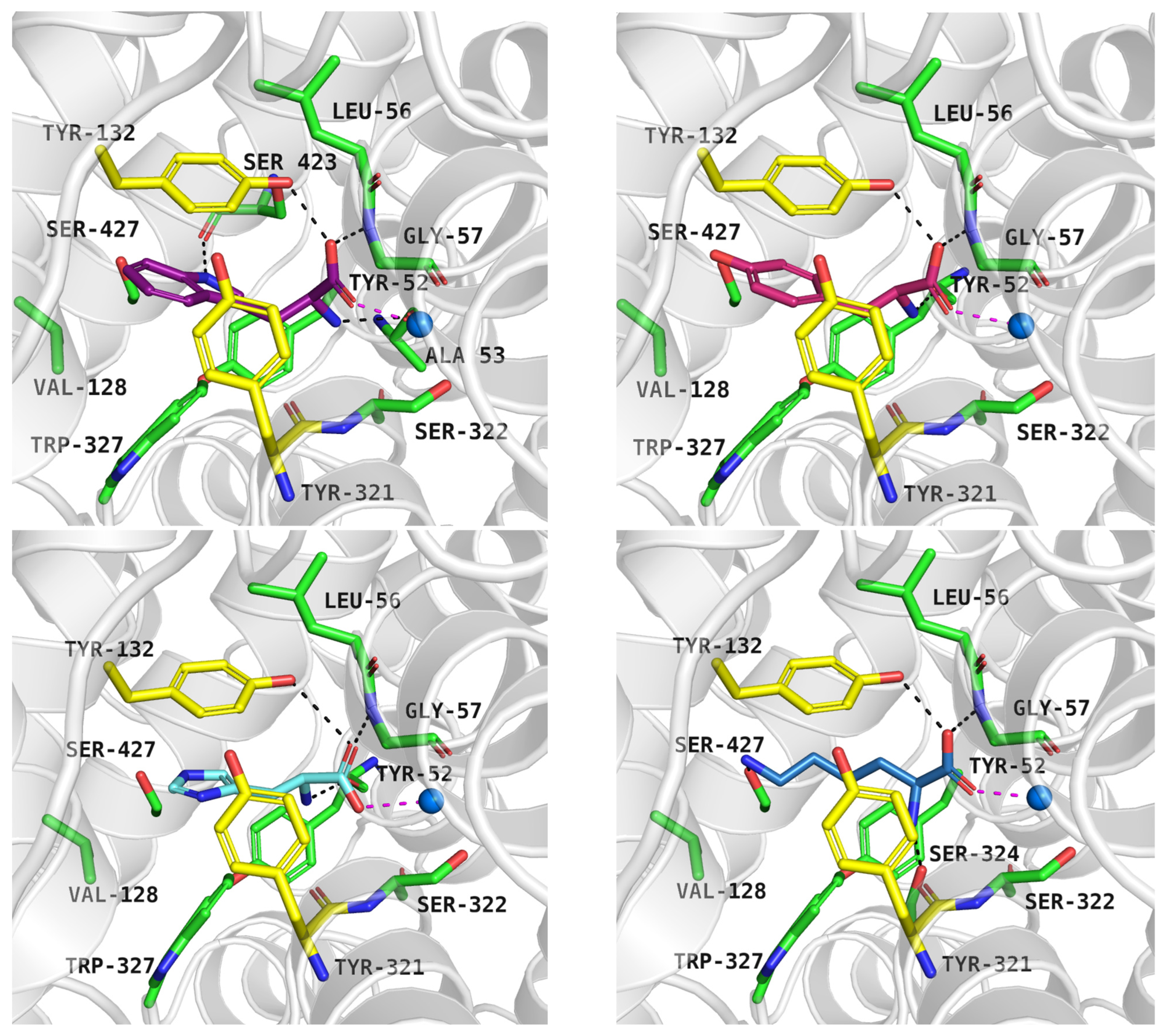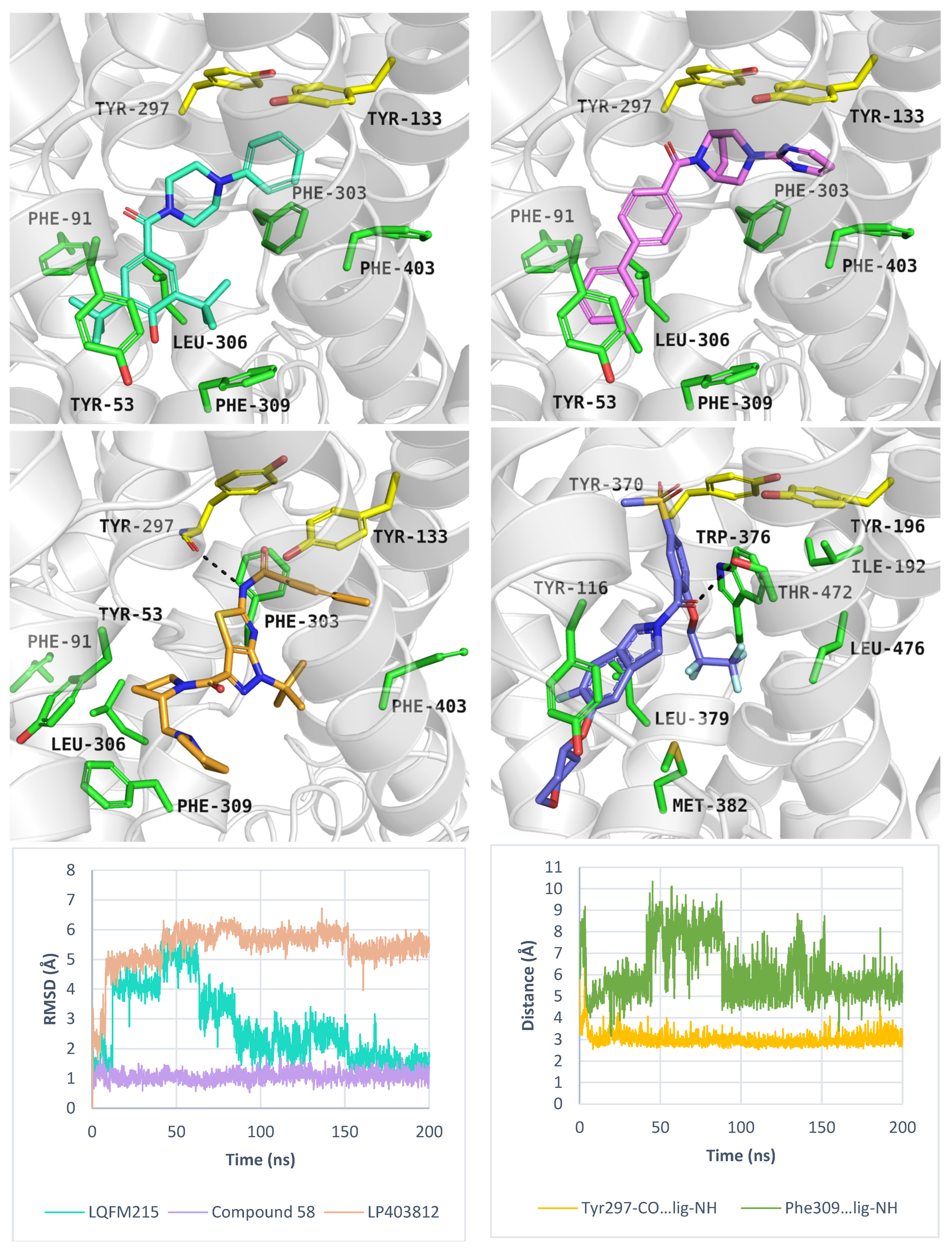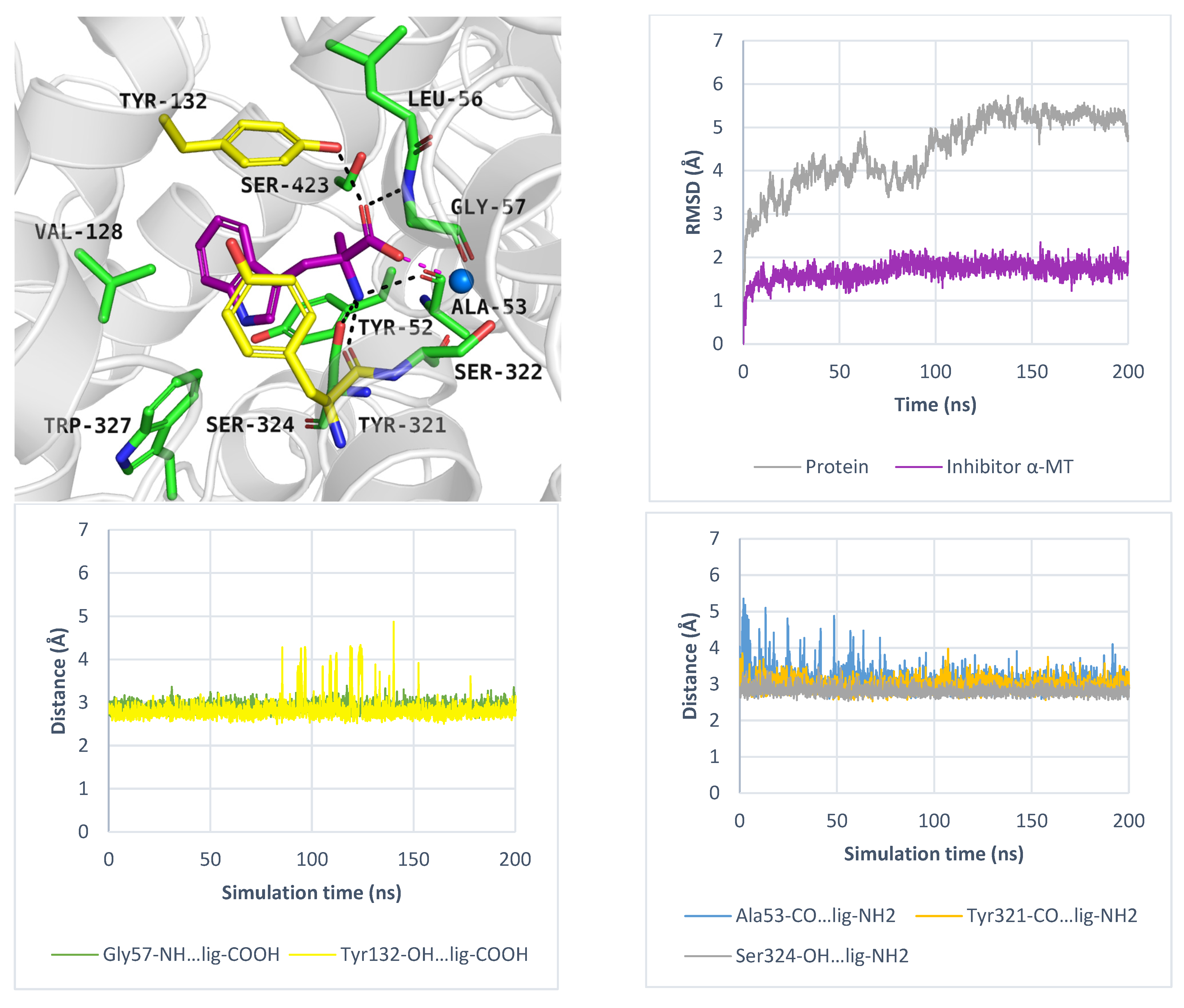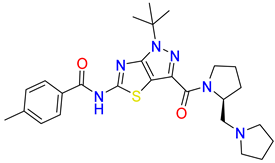Unveiling the Structure of PROT and ATB0,+: Unique Members of the Glycine Transporter Subfamily
Abstract
1. Introduction
2. Results and Discussion
2.1. Model Building and Evaluation
2.2. Structure of PROT and ATB0,+ Transporters
2.2.1. Overall Structure and Mechanism of Action
2.2.2. Binding Site Residues
2.3. Docking Studies and Molecular Dynamics Simulation
2.3.1. Binding Mode of Substrates to Glycine Transporter Subfamily
2.3.2. Docking of Inhibitors of PROT and ATB0,+ Transporters
3. Materials and Methods
3.1. Homology Modelling
3.2. Docking Studies
3.3. MM-GBSA Calculation
3.4. Molecular Dynamics Simulations
4. Conclusions
Supplementary Materials
Author Contributions
Funding
Institutional Review Board Statement
Informed Consent Statement
Data Availability Statement
Acknowledgments
Conflicts of Interest
References
- Pramod, A.B.; Foster, J.; Carvelli, L.; Henry, L.K. SLC6 Transporters: Structure, Function, Regulation, Disease Association and Therapeutics. Mol. Asp. Med. 2013, 34, 197–219. [Google Scholar] [CrossRef] [PubMed]
- Rudnick, G.; Krämer, R.; Blakely, R.D.; Murphy, D.L.; Verrey, F. The SLC6 Transporters: Perspectives on Structure, Functions, Regulation, and Models for Transporter Dysfunction. Pflug. Arch. 2014, 466, 25–42. [Google Scholar] [CrossRef]
- Velaz-Faircloth, M.; Guadano-Ferraz, A.; Henzi, V.A.; Fremeau, R.T. Mammalian Brain-Specific L-Proline Transporter. Neuronal Localization of MRNA and Enrichment of Transporter Protein in Synaptic Plasma Membranes. J. Biol. Chem. 1995, 270, 15755–15761. [Google Scholar] [CrossRef] [PubMed]
- Renick, S.E.; Kleven, D.T.; Chan, J.; Stenius, K.; Milner, T.A.; Pickel, V.M.; Fremeau, R.T. The Mammalian Brain High-Affinity L-Proline Transporter Is Enriched Preferentially in Synaptic Vesicles in a Subpopulation of Excitatory Nerve Terminals in Rat Forebrain. J. Neurosci. 1999, 19, 21–33. [Google Scholar] [CrossRef] [PubMed]
- Nałęcz, K.A. Amino Acid Transporter SLC6A14 (ATB0,+)—A Target in Combined Anti-Cancer Therapy. Front. Cell Dev. Biol. 2020, 8, 594464. [Google Scholar] [CrossRef]
- Sloan, J.L.; Mager, S. Cloning and Functional Expression of a Human Na+ and Cl−-Dependent Neutral and Cationic Amino Acid Transporter B0+. J. Biol. Chem. 1999, 274, 23740–23745. [Google Scholar] [CrossRef]
- Sivaprakasam, S.; Sikder, M.O.F.; Ramalingam, L.; Kaur, G.; Dufour, J.M.; Moustaid-Moussa, N.; Wachtel, M.S.; Ganapathy, V. SLC6A14 Deficiency Is Linked to Obesity, Fatty Liver, and Metabolic Syndrome but Only under Conditions of a High-Fat Diet. Biochim. Biophys. Acta Mol. Basis Dis. 2021, 1867, 166087. [Google Scholar] [CrossRef]
- SLC6A14 Solute Carrier Family 6 Member 14 [Homo Sapiens (Human)]—Gene—NCBI. Available online: https://www.ncbi.nlm.nih.gov/gene/11254 (accessed on 23 March 2022).
- Carvalho, G.A.; Chiareli, R.A.; Marques, B.L.; Parreira, R.C.; de Souza Gil, E.; de Carvalho, F.S.; da Rocha, A.L.B.; Silva, R.R.; Noël, F.; Vaz, B.G.; et al. L-Proline Transporter Inhibitor (LQFM215) Promotes Neuroprotection in Ischemic Stroke. Pharmacol. Rep. 2023, 75, 276–292. [Google Scholar] [CrossRef]
- Carvalho, G.A.; Chiareli, R.A.; Pedrazzi, J.F.C.; Silva-Amaral, D.; da Rocha, A.L.B.; Oliveira-Lima, O.C.; Lião, L.M.; de Souza-Fagundes, E.M.; Schildknecht, S.; Leist, M.; et al. Novel Proline Transporter Inhibitor (LQFM215) Presents Antipsychotic Effect in Ketamine Model of Schizophrenia. Neurochem. Res. 2024, 49, 170–183. [Google Scholar] [CrossRef]
- Napierala, J.S.; Li, Y.; Lu, Y.; Lin, K.; Hauser, L.A.; Lynch, D.R.; Napierala, M. Comprehensive Analysis of Gene Expression Patterns in Friedreich’s Ataxia Fibroblasts by RNA Sequencing Reveals Altered Levels of Protein Synthesis Factors and Solute Carriers. Dis. Model. Mech. 2017, 10, 1353–1369. [Google Scholar] [CrossRef]
- Reid, K.M.; Spaull, R.; Salian, S.; Barwick, K.; Meyer, E.; Zhen, J.; Hirata, H.; Sheipouri, D.; Benkerroum, H.; Gorman, K.M.; et al. MED27, SLC6A7, and MPPE1 Variants in a Complex Neurodevelopmental Disorder with Severe Dystonia. Mov. Disord. 2022, 37, 2139–2146. [Google Scholar] [CrossRef]
- Hager, J.; Philippi, A.; Roschmann, E. Human Autism Susceptibility Gene and Uses Thereof. U.S. Patent AU2004267247B2, 14 June 2007. [Google Scholar]
- Mao, H.; Sheng, J.; Jia, J.; Wang, C.; Zhang, S.; Li, H.; He, F. Aberrant Slc6a14 Expression Promotes Proliferation and Metastasis of Colorectal Cancer via Enhancing the Jak2/Stat3 Pathway. Onco Targets Ther. 2021, 14, 379–392. [Google Scholar] [CrossRef] [PubMed]
- Gupta, N.; Miyauchi, S.; Martindale, R.G.; Herdman, A.V.; Podolsky, R.; Miyake, K.; Mager, S.; Prasad, P.D.; Ganapathy, M.E.; Ganapathy, V. Upregulation of the Amino Acid Transporter ATB0,+ (SLC6A14) in Colorectal Cancer and Metastasis in Humans. Biochim. Biophys. Acta Mol. Basis Dis. 2005, 1741, 215–223. [Google Scholar] [CrossRef]
- Karunakaran, S.; Ramachandran, S.; Coothankandaswamy, V.; Elangovan, S.; Babu, E.; Periyasamy-Thandavan, S.; Gurav, A.; Gnanaprakasam, J.P.; Singh, N.; Schoenlein, P.V.; et al. SLC6A14 (ATB0,+) Protein, a Highly Concentrative and Broad Specific Amino Acid Transporter, Is a Novel and Effective Drug Target for Treatment of Estrogen Receptor-Positive Breast Cancer. J. Biol. Chem. 2011, 286, 31830–31838. [Google Scholar] [CrossRef]
- Gupta, N.; Prasad, P.D.; Ghamande, S.; Moore-Martin, P.; Herdman, A.V.; Martindale, R.G.; Podolsky, R.; Mager, S.; Ganapathy, M.E.; Ganapathy, V. Up-Regulation of the Amino Acid Transporter ATB0,+ (SLC6A14) in Carcinoma of the Cervix. Gynecol. Oncol. 2006, 100, 8–13. [Google Scholar] [CrossRef] [PubMed]
- Coothankandaswamy, V.; Cao, S.; Xu, Y.; Prasad, P.D.; Singh, P.K.; Reynolds, C.P.; Yang, S.; Ogura, J.; Ganapathy, V.; Bhutia, Y.D. Amino Acid Transporter SLC6A14 Is a Novel and Effective Drug Target for Pancreatic Cancer. Br. J. Pharmacol. 2016, 173, 3292–3306. [Google Scholar] [CrossRef]
- Lu, Y.; Jiang, Z.; Wang, K.; Yu, S.; Hao, C.; Ma, Z.; Fu, X.; Qin, M.Q.; Xu, Z.; Fan, L. Blockade of the Amino Acid Transporter SLC6A14 Suppresses Tumor Growth in Colorectal Cancer. BMC Cancer 2022, 22, 833. [Google Scholar] [CrossRef]
- Dang, C.; Bian, Q.; Wang, F.; Wang, H.; Liang, Z. Machine Learning Identifies SLC6A14 as a Novel Biomarker Promoting the Proliferation and Metastasis of Pancreatic Cancer via Wnt/β-Catenin Signaling. Sci. Rep. 2024, 14, 2116. [Google Scholar] [CrossRef] [PubMed]
- Su, Y.; Li, J.; Chen, Y.; Bao, J.; Lei, Z.; Ma, M.; Zhang, W.; Liu, Q.; Xu, B.; Hu, T.; et al. α-Methyl-Tryptophan Inhibits SLC6A14 Expression and Exhibits Immunomodulatory Effects in Crohn’s Disease. J. Inflamm. Res. 2025, 18, 1127–1145. [Google Scholar] [CrossRef]
- Bhutia, Y.D.; Mathew, M.; Sivaprakasam, S.; Ramachandran, S.; Ganapathy, V. Unconventional Functions of Amino Acid Transporters: Role in Macropinocytosis (SLC38A5/SLC38A3) and Diet-Induced Obesity/Metabolic Syndrome (SLC6A19/SLC6A14/SLC6A6). Biomolecules 2022, 12, 235. [Google Scholar] [CrossRef]
- Mercier, J.; Calmel, C.; Mésinèle, J.; Sutanto, E.; Merabtene, F.; Longchampt, E.; Sage, E.; Kicic, A.; Boëlle, P.-Y.; Corvol, H.; et al. SLC6A14 Impacts Cystic Fibrosis Lung Disease Severity via MTOR and Epithelial Repair Modulation. Front. Mol. Biosci. 2022, 9, 850261. [Google Scholar] [CrossRef] [PubMed]
- Noveski, P.; Mircevska, M.; Plaseski, T.; Peterlin, B.; Plaseska-Karanfilska, D. Study of Three Single Nucleotide Polymorphisms in the SLC6A14 Gene in Association with Male Infertility. Balk. J. Med. Genet. 2015, 17, 61–66. [Google Scholar] [CrossRef]
- Shahsavar, A.; Stohler, P.; Bourenkov, G.; Zimmermann, I.; Siegrist, M.; Guba, W.; Pinard, E.; Sinning, S.; Seeger, M.A.; Schneider, T.R.; et al. Structural Insights into the Inhibition of Glycine Reuptake. Nature 2021, 591, 677–681. [Google Scholar] [CrossRef]
- Berman, H.M.; Westbrook, J.; Feng, Z.; Gilliland, G.; Bhat, T.N.; Weissig, H.; Shindyalov, I.N.; Bourne, P.E. The Protein Data Bank. Nucleic Acids Res. 2000, 28, 235–242. [Google Scholar] [CrossRef]
- Motiwala, Z.; Aduri, N.G.; Shaye, H.; Han, G.W.; Lam, J.H.; Katritch, V.; Cherezov, V.; Gati, C. Structural Basis of GABA Reuptake Inhibition. Nature 2022, 606, 820–826. [Google Scholar] [CrossRef] [PubMed]
- Kukułowicz, J.; Bajda, M. In Silico Structural Studies on the Vesicular Neutral Amino Acid Transporter NTT4 (SLC6A17). Comput. Struct. Biotechnol. J. 2024, 23, 3342–3347. [Google Scholar] [CrossRef]
- Li, Y.; Chen, Y.; Zhang, Y.; Shen, Y.; Xu, K.; Liu, Y.; Wang, Z.; Yan, R. Structural Insight into the Substrate Recognition and Transport Mechanism of Amino Acid Transporter Complex ACE2-B0AT1 and ACE2-SIT1. Cell Discov. 2023, 9, 93. [Google Scholar] [CrossRef]
- Stary, D.; Bajda, M. Structural Studies of the Taurine Transporter: A Potential Biological Target from the GABA Transporter Subfamily in Cancer Therapy. Int. J. Mol. Sci. 2024, 25, 7339. [Google Scholar] [CrossRef] [PubMed]
- Li, H.Z.; Pike, A.C.W.; Lotsaris, I.; Chi, G.; Hansen, J.S.; Lee, S.C.; Rödström, K.E.J.; Bushell, S.R.; Speedman, D.; Evans, A.; et al. Structure and Function of the SIT1 Proline Transporter in Complex with the COVID-19 Receptor ACE2. Nat. Commun. 2024, 15, 5503. [Google Scholar] [CrossRef]
- Beuming, T.; Shi, L.; Javitch, J.A.; Weinstein, H. A Comprehensive Structure-Based Alignment of Prokaryotic and Eukaryotic Neurotransmitter/Na+ Symporters (NSS) Aids in the Use of the LeuT Structure to Probe NSS Structure and Function. Mol. Pharmacol. 2006, 70, 1630–1642. [Google Scholar] [CrossRef]
- Łątka, K.; Jończyk, J.; Bajda, M. Structure Modeling of γ-Aminobutyric Acid Transporters—Molecular Basics of Ligand Selectivity. Int. J. Biol. Macromol. 2020, 158, 1380–1389. [Google Scholar] [CrossRef]
- Kristensen, A.S.; Andersen, J.; Jorgensen, T.N.; Sorensen, L.; Eriksen, J.; Loland, C.J.; Stromgaard, K.; Gether, U. SLC6 Neurotransmitter Transporters: Structure, Function, and Regulation. Pharmacol. Rev. 2011, 63, 585–640. [Google Scholar] [CrossRef]
- Wei, Y.; Li, R.; Meng, Y.; Hu, T.; Zhao, J.; Gao, Y.; Bai, Q.; Li, N.; Zhao, Y. Transport Mechanism and Pharmacology of the Human GlyT1. Cell 2024, 187, 1719–1732.e14. [Google Scholar] [CrossRef]
- Subramanian, N.; Scopelitti, A.J.; Carland, J.E.; Ryan, R.M.; O’Mara, M.L.; Vandenberg, R.J. Identification of a 3rd Na+ Binding Site of the Glycine Transporter, GlyT2. PLoS ONE 2016, 11, e0157583. [Google Scholar] [CrossRef]
- Benito-Muñoz, C.; Perona, A.; Felipe, R.; Pérez-Siles, G.; Núñez, E.; Aragón, C.; López-Corcuera, B. Structural Determinants of the Neuronal Glycine Transporter 2 for the Selective Inhibitors ALX1393 and ORG25543. ACS Chem. Neurosci. 2021, 12, 1860–1872. [Google Scholar] [CrossRef]
- Bismuth, Y.; Kavanaugh, M.P.; Kanner, B.I. Tyrosine 140 of the γ-Aminobutyric Acid Transporter GAT-1 Plays a Critical Role in Neurotransmitter Recognition. J. Biol. Chem. 1997, 272, 16096–16102. [Google Scholar] [CrossRef]
- Chan, M.C.; Selvam, B.; Young, H.J.; Procko, E.; Shukla, D. The Substrate Import Mechanism of the Human Serotonin Transporter. Biophys. J. 2022, 121, 715–730. [Google Scholar] [CrossRef]
- Bröer, S.; Rudnick, G. SLC6 Neurotransmitter Transporter Family in GtoPdb v.2023.1. IUPHAR/BPS Guide Pharmacol. CITE 2023, 2023. [Google Scholar] [CrossRef]
- Shi, Y.; Wang, J.; Ndaru, E.; Grewer, C. Pre-Steady-State Kinetic Analysis of Amino Acid Transporter SLC6A14 Reveals Rapid Turnover Rate and Substrate Translocation. Front. Physiol. 2021, 12, 777050. [Google Scholar] [CrossRef]
- Le Guellec, B.; Rousseau, F.; Bied, M.; Supplisson, S. Flux Coupling, Not Specificity, Shapes the Transport and Phylogeny of SLC6 Glycine Transporters. Proc. Natl. Acad. Sci. USA 2022, 119, e2205874119. [Google Scholar] [CrossRef] [PubMed]
- Benito-Muñoz, C.; Perona, A.; Abia, D.; dos Santos, H.G.; Núñez, E.; Aragón, C.; López-Corcuera, B. Modification of a Putative Third Sodium Site in the Glycine Transporter GlyT2 Influences the Chloride Dependence of Substrate Transport. Front. Mol. Neurosci. 2018, 11, 347. [Google Scholar] [CrossRef]
- Anderson, C.M.H.; Edwards, N.; Watson, A.K.; Althaus, M.; Thwaites, D.T. Reshaping the Binding Pocket of the Neurotransmitter:Solute Symporter (NSS) Family Transporter SLC6A14 (ATB0,+) Selectively Reduces Access for Cationic Amino Acids and Derivatives. Biomolecules 2022, 12, 1404. [Google Scholar] [CrossRef]
- Carland, J.E.; Thomas, M.; Mostyn, S.N.; Subramanian, N.; O’Mara, M.L.; Ryan, R.M.; Vandenberg, R.J. Molecular Determinants for Substrate Interactions with the Glycine Transporter GlyT2. ACS Chem. Neurosci. 2018, 9, 603–614. [Google Scholar] [CrossRef]
- LeVine, M.V.; Terry, D.S.; Khelashvili, G.; Siegel, Z.S.; Quick, M.; Javitch, J.A.; Blanchard, S.C.; Weinstein, H. The Allosteric Mechanism of Substrate-Specific Transport in SLC6 Is Mediated by a Volumetric Sensor. Proc. Natl. Acad. Sci. USA 2019, 116, 15947–15956. [Google Scholar] [CrossRef] [PubMed]
- Hatanaka, T.; Huang, W.; Nakanishi, T.; Bridges, C.C.; Smith, S.B.; Prasad, P.D.; Ganapathy, M.E.; Ganapathy, V. Transport of D-Serine via the Amino Acid Transporter ATB0,+ Expressed in the Colon. Biochem. Biophys. Res. Commun. 2002, 291, 291–295. [Google Scholar] [CrossRef]
- Palazzolo, L.; Paravicini, C.; Laurenzi, T.; Adobati, S.; Saporiti, S.; Guerrini, U.; Gianazza, E.; Indiveri, C.; Anderson, C.M.H.; Thwaites, D.T.; et al. SLC6A14, a Pivotal Actor on Cancer Stage: When Function Meets Structure. SLAS Discov. 2019, 24, 928–938. [Google Scholar] [CrossRef] [PubMed]
- Yamashita, A.; Singh, S.K.; Kawate, T.; Jin, Y.; Gouaux, E. Crystal Structure of a Bacterial Homologue of Na+/Cl−-Dependent Neurotransmitter Transporters. Nature 2005, 437, 215–223. [Google Scholar] [CrossRef]
- Łątka, K.; Bajda, M. Analysis of Binding Determinants for Different Classes of Competitive and Noncompetitive Inhibitors of Glycine Transporters. Int. J. Mol. Sci. 2022, 23, 8050. [Google Scholar] [CrossRef] [PubMed]
- Yu, X.C.; Zhang, W.; Oldham, A.; Buxton, E.; Patel, S.; Nghi, N.; Tran, D.; Lanthorn, T.H.; Bomont, C.; Shi, Z.C.; et al. Discovery and Characterization of Potent Small Molecule Inhibitors of the High Affinity Proline Transporter. Neurosci. Lett. 2009, 451, 212–216. [Google Scholar] [CrossRef]
- Zipp, G.G.; Barbosa, J.; Green, M.A.; Terranova, K.M.; Fink, C.; Yu, X.C.; Nouraldeen, A.; Wilson, A.; Savelieva, K.; Lanthorn, T.H.; et al. Novel Inhibitors of the High-Affinity l-Proline Transporter as Potential Therapeutic Agents for the Treatment of Cognitive Disorders. Bioorg. Med. Chem. Lett. 2014, 24, 3886–3890. [Google Scholar] [CrossRef]
- Li, M.-M.; Huang, H.; Pu, Y.; Tian, W.; Deng, Y.; Lu, J. A Close Look into the Biological and Synthetic Aspects of Fused Pyrazole Derivatives. Eur. J. Med. Chem. 2022, 243, 114739. [Google Scholar] [CrossRef]
- Karunakaran, S.; Umapathy, N.S.; Thangaraju, M.; Hatanaka, T.; Itagaki, S.; Munn, D.H.; Prasad, P.D.; Ganapathy, V. Interaction of Tryptophan Derivatives with SLC6A14 (ATB0,+) Reveals the Potential of the Transporter as a Drug Target for Cancer Chemotherapy. Biochem. J. 2008, 414, 343–355. [Google Scholar] [CrossRef]
- Almeida De Carvalho, G.; Tambwe, P.M.; Rodrigues, L.; Nascimento, C.; Kelly, B.; Campos, P.; Chiareli, R.A.; Pereira, G.; Junior, N.; Menegatti, R.; et al. In Silico Evidence of Bitopertin’s Broad Interactions within the SLC6 Transporter Family. J. Pharm. Pharmacol. 2024, 76, 1199–1211. [Google Scholar] [CrossRef] [PubMed]
- UniProt. Available online: https://www.uniprot.org/ (accessed on 14 October 2021).
- Bioinformatics Tools for Multiple Sequence Alignment < EMBL-EBI. Available online: https://www.ebi.ac.uk/Tools/msa/ (accessed on 22 November 2021).
- Clamp, M.; Cuff, J.; Searle, S.M.; Barton, G.J. The Jalview Java Alignment Editor. Bioinformatics 2004, 20, 426–427. [Google Scholar] [CrossRef] [PubMed]
- Lomize, M.A.; Pogozheva, I.D.; Joo, H.; Mosberg, H.I.; Lomize, A.L. OPM Database and PPM Web Server: Resources for Positioning of Proteins in Membranes. Nucleic Acids Res. 2012, 40, D370–D376. [Google Scholar] [CrossRef]
- Singh, S.K.; Piscitelli, C.L.; Yamashita, A.; Gouaux, E. A competitive inhibitor traps LeuT in an open-to-out conformation. Science (1979) 2008, 322, 1655–1661. [Google Scholar] [CrossRef]
- Wang, H.; Goehring, A.; Wang, K.H.; Penmatsa, A.; Ressler, R.; Gouaux, E. Structural basis for action by diverse antidepressants on biogenic amine transporters. Nature 2013, 503, 141–145. [Google Scholar] [CrossRef] [PubMed]
- Wang, K.H.; Penmatsa, A.; Gouaux, E. Neurotransmitter and psychostimulant recognition by the dopamine transporter. Nature 2015, 521, 322–327. [Google Scholar] [CrossRef]
- Pidathala, S.; Mallela, A.K.; Joseph, D.; Penmatsa, A. Structural basis of norepinephrine recognition and transport inhibition in neurotransmitter transporters. Nat. Commun. 2021, 12, 2199. [Google Scholar] [CrossRef]
- Coleman, J.A.; Green, E.M.; Gouaux, E. X-ray structures and mechanism of the human serotonin transporter. Nature 2016, 532, 334–339. [Google Scholar] [CrossRef]
- Zhu, A.; Huang, J.; Kong, F.; Tan, J.; Lei, J.; Yuan, Y.; Yan, C. Molecular basis for substrate recognition and transport of human GABA transporter GAT1. Nat. Struct. Mol. Biol. 2023, 30, 1012–1022. [Google Scholar] [CrossRef] [PubMed]

 ), intracellular gate—pink (
), intracellular gate—pink ( ). Residues involved in ion binding are marked with circles: Na+1 binding site—blue (
). Residues involved in ion binding are marked with circles: Na+1 binding site—blue ( ), Na+2 binding site—light blue (
), Na+2 binding site—light blue ( ) and Cl− binding site—red (
) and Cl− binding site—red ( ). Potential residues for Na+3 site in GlyT2 or ATB0+ are not marked. Amino acids involved in ligand binding are marked with a rectangle: S2 site binding site—violet (
). Potential residues for Na+3 site in GlyT2 or ATB0+ are not marked. Amino acids involved in ligand binding are marked with a rectangle: S2 site binding site—violet ( ), S1 binding site—green (
), S1 binding site—green ( ).
).
 ), intracellular gate—pink (
), intracellular gate—pink ( ). Residues involved in ion binding are marked with circles: Na+1 binding site—blue (
). Residues involved in ion binding are marked with circles: Na+1 binding site—blue ( ), Na+2 binding site—light blue (
), Na+2 binding site—light blue ( ) and Cl− binding site—red (
) and Cl− binding site—red ( ). Potential residues for Na+3 site in GlyT2 or ATB0+ are not marked. Amino acids involved in ligand binding are marked with a rectangle: S2 site binding site—violet (
). Potential residues for Na+3 site in GlyT2 or ATB0+ are not marked. Amino acids involved in ligand binding are marked with a rectangle: S2 site binding site—violet ( ), S1 binding site—green (
), S1 binding site—green ( ).
).









| Sequences | dDAT | aLeuT | hSERT | hGlyT1 | hGAT1 | hSIT1 | ||||||
|---|---|---|---|---|---|---|---|---|---|---|---|---|
| Identity (I.), Similarity (S.) | I. [%] | S. [%] | I. [%] | S. [%] | I. [%] | S. [%] | I. [%] | S. [%] | I. [%] | S. [%] | I. [%] | S. [%] |
| hPROT | 41.7 | 58.3 | 22.1 | 36.8 | 36.2 | 51.5 | 43.1 | 60.2 | 40.4 | 58.4 | 29.4 | 43.4 |
| hATB0,+ | 40.1 | 55.9 | 19.8 | 34.2 | 36.0 | 53.6 | 37.1 | 54.1 | 38.5 | 55.8 | 29.7 | 44.8 |
| hGlyT1 | 35.3 | 51.0 | 17.5 | 30.3 | 34.7 | 53.2 | 100.0 | 100.0 | 53.2 | 36.4 | 27.7 | 40.9 |
| hGlyT2 | 33.9 | 47.8 | 18.4 | 30.3 | 33.2 | 48.6 | 38.9 | 55.1 | 33.9 | 48.2 | 25.9 | 40.7 |
| Protein | S1 Binding Site | Intracellular Gate | ||||||||||
|---|---|---|---|---|---|---|---|---|---|---|---|---|
| hPROT | Tyr53 | Gly56 | Leu57 | Gly58 | Val129 | Gly300 | Phe303 | Phe403 | Arg37 | Trp40 | Ser311 | Asp413 |
| hATB0,+ | Tyr52 | Gly55 | Leu56 | Gly57 | Val128 | Ser324 | Trp327 | Ser427 | Arg36 | Trp39 | Ser322 | Asp437 |
| hGlyT1 | Tyr116 | Gly119 | Leu120 | Gly121 | Ile192 | Gly373 | Trp376 | Leu476 | Arg100 | Trp103 | Ser384 | Asp486 |
| hGlyT2 | Tyr207 | Gly210 | Leu211 | Gly212 | Ile283 | Ser479 | Trp482 | Thr582 | Arg191 | Trp194 | Ser490 | Asp592 |
| aLeuT | Asn21 | Gly24 | Leu25 | Gly26 | Val104 | Ser256 | Phe259 | Ile359 | Arg5 | Trp8 | Asn361 | Asp369 |
| PROT | GlyT1 | GlyT2 |
|---|---|---|
 |  |  |
| Proline | Glycine | Glycine |
| ATB0,+ | ||
 |  |  |
| Isoleucine | Leucine | Methionine |
 |  |  |
| Tyrosine | Tryptophan | Histidine |
 |  |  |
| Lysine | Arginine | Glycine |
Disclaimer/Publisher’s Note: The statements, opinions and data contained in all publications are solely those of the individual author(s) and contributor(s) and not of MDPI and/or the editor(s). MDPI and/or the editor(s) disclaim responsibility for any injury to people or property resulting from any ideas, methods, instructions or products referred to in the content. |
© 2025 by the authors. Licensee MDPI, Basel, Switzerland. This article is an open access article distributed under the terms and conditions of the Creative Commons Attribution (CC BY) license (https://creativecommons.org/licenses/by/4.0/).
Share and Cite
Stary, D.; Bajda, M. Unveiling the Structure of PROT and ATB0,+: Unique Members of the Glycine Transporter Subfamily. Molecules 2025, 30, 4412. https://doi.org/10.3390/molecules30224412
Stary D, Bajda M. Unveiling the Structure of PROT and ATB0,+: Unique Members of the Glycine Transporter Subfamily. Molecules. 2025; 30(22):4412. https://doi.org/10.3390/molecules30224412
Chicago/Turabian StyleStary, Dorota, and Marek Bajda. 2025. "Unveiling the Structure of PROT and ATB0,+: Unique Members of the Glycine Transporter Subfamily" Molecules 30, no. 22: 4412. https://doi.org/10.3390/molecules30224412
APA StyleStary, D., & Bajda, M. (2025). Unveiling the Structure of PROT and ATB0,+: Unique Members of the Glycine Transporter Subfamily. Molecules, 30(22), 4412. https://doi.org/10.3390/molecules30224412









